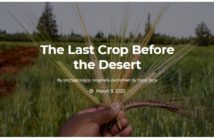FINANCIAL TIMES
By Louise Lucas
©Bloomberg
Energy debate: corn being harvested for biofuels in Missouri. Critics say such use keeps poor people hungry
Food has never been such a global issue. Some 1.5bn overweight and obese adults share the planet with 870m chronically hungry people, and governments are grappling with the same challenges: how to produce more food from less land, slash waste and reduce price volatility, while battling erratic climate patterns.
UN projections illustrate the scale of that challenge against the background of an increasing population and lacklustre production growth: in order to feed the expected 2bn additional bellies expected by 2050, we will need to grow 70 per cent more food.
But, as data from the Food and Agricultural Organisation show that one in eight people go to bed hungry, it is clear that problems already exist.
And far from being a poor-world issue, hunger levels are rising in the developed world. In the US, a record 46.7m people used food stamps in July, while the UK is likely to reach its own milestone this year, as 200,000 families are expected to receive emergency supplies from food banks this year, according to the Trussell Trust.
Luca Chinotti, an adviser with Oxfam, the charity, describes the fact that so many went hungry in 2010-12 – more than the population of the US, Europe and Canada – in a world that now produces sufficient food, as “the biggest scandal of our time”.
Citing the usual culprits – political inaction, lack of investment, land grabs and climate change – he insists: “We need a new approach to the way we grow, share and manage food and other natural resources.”
Farmers, manufacturers, government and other policy makers are generally in accord; discrepancies lie over responses and the pace of change required. Many argue there is enough food, but say it is simply in the wrong place. In the richer parts of the globe, about a third of food is estimated to end up as waste, while in India poor storage means a similar amount or more of produce rots before it gets from the fields to processors.
Other suggestions that have been mooted are causing more angst. Technologies such as genetically modified foods are banned in whole swaths of the globe. Use of food crops for renewable fuels also raises hackles. This, together with speculators, has been blamed for the era of high and volatile food prices that peaked last year.
ActionAid, the non-governmental organisation, quotes research from Tufts University showing that from 2005-06 to 2010-11, US ethanol expansion cost net corn importing countries $11.6bn in higher corn prices – more than half of which was borne by emerging markets.
Noting that challenges include environmental concerns as well as food availability, Carlos da Silva, a senior agribusiness economist at the FAO, puts it this way: “Policy makers have to balance these, and sometimes they can be conflicting.”
For many, the answer is a new “green revolution”, a recreation of the agrarian revolution that began sweeping through countrysides and raising yields from the 1940s. Since the 1970s, investment has tailed off and, with it, productivity gains.
“I think the problems are bigger and more urgent than governments seem to be reflecting,” says Roger Sylvester-Bradley, principal research scientist at Adas, the natural agricultural and environmental consultancy that has advised on UK government reports into food production. He suggests increasing government investment, although, like others, he also foresees a future where the cost of foodstuffs better reflects their toll on the environment and other resources.
As well as more cash, he would like to see it better directed. “Now, the frontiers of biological science have moved from the field into the lab and into minutiae,” he says.
During the current eurozone financial crisis, it is unsurprising few governments have the stomach to tackle food security in a co-ordinated way.
It will require agreement from countries with vastly different dynamics – urbanising China, where farmers are fleeing the countryside; car-happy America – and a somewhat weak food chain with fragmented links.
At the bottom are the people who till the land. Many are subsistence farmers, barely eking out their own living, with some of the highest suicide rates of any employee sector.
Unlike other labour forces, farmers are not organised, and many operate as single families. As poor credit risks, whose income is at the mercy of the weather and often fickle customers, many have limited access to short-term credit, and virtually none to long-term loans.
This is where manufacturers are stepping in. As corporate head of agriculture for Nestlé, the world’s biggest food company – and himself a former farmer – Hans Jöhr spends much of his time down on the farm.
“We try to help farmers to create more interesting business models,” he says. “So they have a better income, so smallholder farming becomes more attractive again and retains people.”
Thus Nestlé, like its peers, employs vast teams of agronomists who train and provide technical expertise to farmers. It also helps them access funds at non-exorbitant rates, and provides a guaranteed market for their goods.
Co-ordination is growing between industry and NGOs, but it still falls short of what is needed. Nor are these the only stakeholders to be letting concerns such as competitive rivalry stand in the way. Equally fragmented, say some, are food agencies tasked with battling hunger. Yet no one is under any illusion. Softening on the promotion of biofuels, more involvement by manufacturers, and government policies to fight hunger are all steps towards tackling food shortages.
Earlier this year, Bill Gates, the Microsoft founder turned philanthropist, broke a taboo in the development community by publicly accusing UN agencies of allowing infighting and inefficiency to undermine their role.
Mr Gates, who has donated some $2bn to food security in the past decade, and plans to give another $2bn in the next five years, told an audience of the three agencies in Rome that the current system was “outdated and inefficient”.
“Countries, food agencies and donors aren’t working together in a focused and co-ordinated way to provide the help small farmers need, when they need it,” he said.
Depending who you speak to, there are far more culpable parties than policy makers and governments.
Traders at investment banks and funds come in for a regular bashing whenever commodity prices rise, even though the charge that they are responsible for much of the escalating prices is not watertight.
The energy industry and governments that have mandated use of biofuels from sugar cane and corn – “taking food from bellies and putting it into motor tanks”, critics say – also have a case to answer.
Many realise as much, hence a backpedalling on regulations. In October, for example, the European Commission moved to limit the use of crop-based biofuels in a revised directive. If adopted, this would allow EU member states to count them towards only half of a 10 per cent target for renewable energy, requiring them to meet the rest through more benign types of biofuels harvested from waste.
“There’s still a long way to go,” says the FAO’s Mr da Silva.
ShareClipReprintsPrintEmail
.







